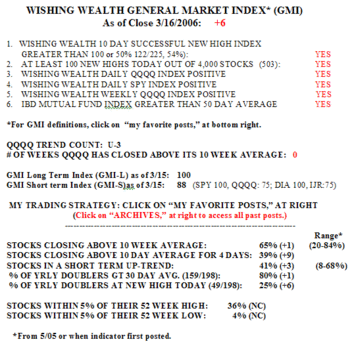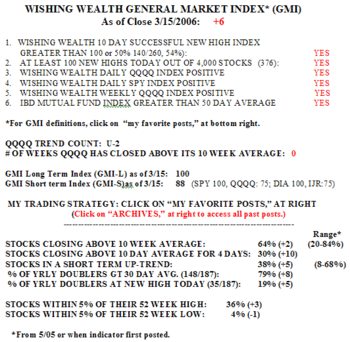I’m taking a rest during spring break. I will return next weekend. Hope to see you then.
All Posts
GMI:+6; breakout stocks doing well
The GMI remains at a maximum +6. There were 503 new 52 week highs in my universe of 4,000 stocks on Thursday, the most since late January. However, only 33% of the Nasdaq 100 stocks advanced, less then the 58% of the S&P 500 stocks and 63% of the Dow 30 stocks.  The Nasdaq 100 is in its third day (U-3) of the new short term up-trend. 41% of stocks are in a short term up trend and 65% closed above their 10 week averages. Meanwhile, many of the break out stocks I mentioned yesterday have done well……
The Nasdaq 100 is in its third day (U-3) of the new short term up-trend. 41% of stocks are in a short term up trend and 65% closed above their 10 week averages. Meanwhile, many of the break out stocks I mentioned yesterday have done well……
Please send your comments to: silentknight@wishingwealthblog.com.
GMI:+6; GMI-L:100; GMI-S: 88; some stocks breaking out from bases
The indexes are finally in synch and in up trends. The GMI is +6 and both the GMI-L and GMI-S are strong.  There were 376 new highs in my universe of 4,000 stocks on Wednesday and 38% of stocks are now in a short term up trend. 66% of the Nasdaq 100 stocks closed Wednesday above their 30 day averages. Many stocks are breaking out of bases on huge volume increases. Wednesday was the second day (U-2) of the new QQQQ short term up trend. 36% of stocks are within 5% of their yearly highs. Among the stocks that appear to have broken out of bases on high volume this week are: AZR, WCN, DEO, DXCM, VTIV (I own this), DXPE, ITW, AVTR, RIMM, STN, MHP, NTES, VNO, DPZ, MAN, and XNPT. CMG, a recent spin off of MCD, also looks strong (I own it, based on my son’s opinion that Chipotle’s food is great, and the recent turnaround in earnings.) Of course, the fundamentals of all of these stocks need to be researched to see if they are as good as the technicals……………..
There were 376 new highs in my universe of 4,000 stocks on Wednesday and 38% of stocks are now in a short term up trend. 66% of the Nasdaq 100 stocks closed Wednesday above their 30 day averages. Many stocks are breaking out of bases on huge volume increases. Wednesday was the second day (U-2) of the new QQQQ short term up trend. 36% of stocks are within 5% of their yearly highs. Among the stocks that appear to have broken out of bases on high volume this week are: AZR, WCN, DEO, DXCM, VTIV (I own this), DXPE, ITW, AVTR, RIMM, STN, MHP, NTES, VNO, DPZ, MAN, and XNPT. CMG, a recent spin off of MCD, also looks strong (I own it, based on my son’s opinion that Chipotle’s food is great, and the recent turnaround in earnings.) Of course, the fundamentals of all of these stocks need to be researched to see if they are as good as the technicals……………..
Please send your comments to: silentknight@wishingwealthblog.com.